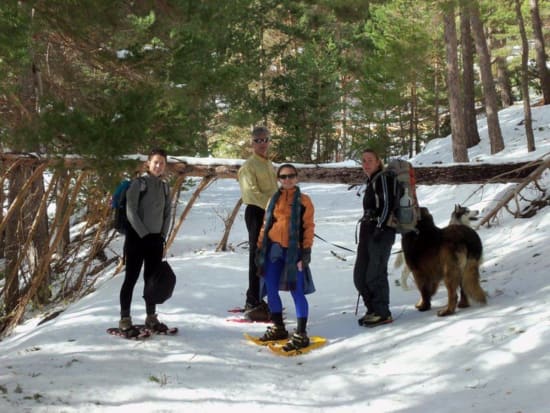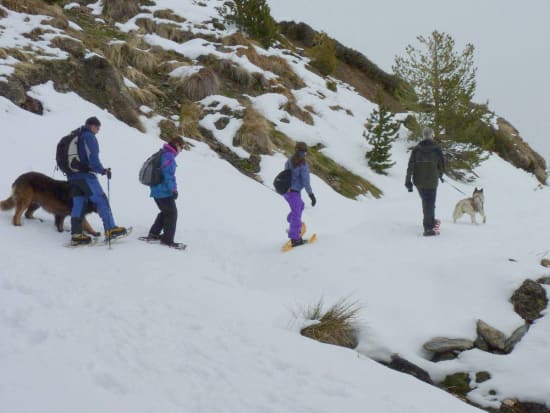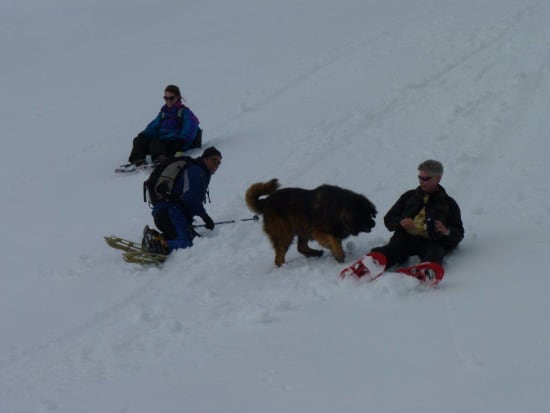Last week we were privileged to enjoy the company of a family from the USA, as we guided them on a days snowshoeing.

Group enjoying the walk through the forests
We parked at the recreation site at Puente Palo, above the village of Cañar. We accessed on another dirt track from Lanjaron. With care a normal saloon car could reach this spot but the road conditions do deteriorate depending on the severity of recent rains.
Puente Palo is situated at about 1700m. We had a zig zag walk up through the forest for about an hour before we encountered our first snows at around the 2000m level. Tracks of wild boar had crossed the path in front of us adding greatly to the pleasure of our excited dogs. The snow deepened and with rising frustration at sinking into the snows, we eventually donned our snowshoes.

Snowshoeing along the mountainside
None of the party had done it before but were keen and eager to learn. That said, there's not really too much to learn really. Put them on your feet and walk like John Wayne! Immediately the going was easier as we crossed interesting slopes on our way to the deserted cortijo at Cañada de Tajos de los Machos. Going up, over and around deep snow drifts added excitement. As did the cloud which drifted in from the south leaving us in thick mist.
With the trees to guide us we made the old cortijo where we had some lunch. Our plans to escape onto the open hillside towards the peak of Cerrillo Redondo had to be curtailed at this point. A party of 6 stumbling around in the mist on a 3000m hill didnt seem to good an idea. Instead we opted for an exhilarating descent alongside a forest break.

Having fun on the descent
Rule number 1 in snowshoeing ................ going down is actually harder than going up (although more fun!). Snowshoes maybe quite good for fall line ascents or descents but for traversing they are not so good. The grip goes and one slides.
Having said that the group had a whale of a time sliding down the slopes alongside the forest. When the snow began to run out at the forest edge we heading in closer to the forest. Some of the guys even went back uphill to try the downhill again!
Of course our excited husky (Khumbu) and leonberger (Bruno) were in their element as they chased us down the white slopes trying to halt our progress.
A good day, yet only 45 minutes from Lanjaron. If you wish to try it our yourself, we can provide all the gear (snowshoes, poles). We are running snowshoeing day and multi day tours throughout the winter and usually up until the end of May.
Read our snowshoeing trip reports.
Extracts from our Guide to Snowshoeing
For Who?
The good news is that anyone who can walk can go snowshoeing. From young kids to senior citizens. Depending on your age and weight range there will be a shoe that will fit your specific needs.
What to Wear?
The good news is you won't need to buy a lot of expensive gear, chances are some of it is probably in your closet! Here is a list of what you could expect to wear on an average outing:
Warm layers: Dress in layers! Put on some toasty non-cotton long underwear as a foundation with an middle insulating layer of fleece or wool. Include an outer layer to block wind or snow if the conditions demand it. You can shed layers as you get warm and put them back on as you cool.
Footwear: Warm socks (wool or polypropylene), waterproof hiking boots, winter boots, or even your waterproof running shoes! Consider buying a pair of gaiters, they're great for keeping your ankles dry in deep powder.
Hat and Gloves: Both of these items are very important for any winter weather. Remember you lose a considerable amount of heat from your head. If you're cold- put a hat on.
Extras: Even though it's cold out, you still need to keep hydrated, so bring the water bottle with! If you're going way out there, carry snacks, a compass and map, first aid kit, and flashlight (or headlamp) too. These things can be carried in a bum bag or day-pack, or simply stash them in a pocket. Poles are suggested for balance, load carrying, hiking in steep terrain, and to take a little bit of weight away from your knees. Give 'em a try! Nearly everyone is a little nervous or intimidated when trying out a new sport. Snowshoeing, however, is a sport that you can enjoy your first time out. Before you go on your first trip take a few minutes to become familiar with your snowshoes. We suggest getting acquainted with your new shoes in the warmth of a building and not out in the cold. The most important aspect is to become familiar with the binding. Follow these simple steps to make sure you have the proper fit every time. Put the ball of your foot over the top of the hinge, centered on the snowshoe. Your toes should be hanging over the front of the foot bed. Tighten the front strap first, followed by the heel strap and finish by tightening the strap over your instep. The straps don't need to be overly tight. Just make sure they are snug. It's that easy! Now you're ready for your first adventure.
How to do it?
Technique: The most important thing to remember is to keep your stride natural. Don't try to modify or exaggerate your gait. Walking or running should feel natural, and in either instance the terrain will dictate your stride. You will have the easiest time learning on gentle, flat, or rolling terrain, but the steeper and deeper the terrain gets, the more challenging and intense your hike or run will get! Another point to remember when beginning snowshoeing is that your snowshoes have a larger "footprint" on the snow than you are probably used to. You might feel awkward for a few hundred yards, but soon your slightly wider stance will feel natural. The solution is to simply concentrate on spreading your feet a bit further apart throughout your stride; this helps you avoid knocking your snowshoe frames together and possibly tripping. The following are some thoughts to keep in mind: remember to lift those knees, think about a wider stance, and avoid dragging or shuffling your feet to prevent the crampons from catching on firm snow. Using a set of poles when snowshoeing will make all of these things come together, all on their own.
Uphill/Downhill/Traversing: When you maneuver up steep slopes, a good technique involves aggressive use of the front crampons. Get your knees up and dig the front points of the crampons into the snow. Remember, the fastest way to the top is straight up - but a more practical method is to cross the slope diagonally. When you are traveling downhill, avoid leaning backwards onto the tails of the snowshoes whenever possible. Try to keep your weight upright and over the center of the snowshoe, and let the front crampons (located under the ball of your foot) grip the snow to prevent sliding. When you are traversing slopes, stay upright and lean into the hill with each step. Keep your weight forward and your crampons beneath you. Short, even strides, as well as traveling with a set of poles, will help avoid slipping and ensure safety.
Deep Snow: Lift your knees and shorten your stride. Your snowshoes are not designed to completely float above the snow, so you will find that you sink a little bit with each step. If you are traveling most often in deep drifts or light, fluffy powder, you may find that getting the next largest size snowshoe will improve your floatation. When in deep snow it is important to tread lightly and pace yourself.
Intensity: The intensity level of snowshoeing is infinitely variable. From a slow walk you can increase intensity by going faster, running, using poles, going uphill, and/or by going through deeper and softer snow. The ease with which you can change the intensity level of snowshoeing is one of the keys to its great value in having fun and as a fitness option. At a minimum, snowshoeing will be a bit more intense than walking or running at any given pace or level due to the cold, weight of the snowshoes, resistance of the snow, etc.
Safety: Snowshoeing is an extremely safe sport. It is also one of the only winter-specific sports that do not depend upon sliding or speed. The manageable and maneuverable nature of modern aluminum-framed snowshoes and the soft forgiving nature of snow combine to make the risk of injury while snowshoeing very low. Snowshoeing involves a natural motion similar to walking, to which the body is accustomed, and is very low impact due to the cushioning of snow. Any wintertime outdoor activity has its risks and snowshoeing is no exception. Take care to avoid the following hazards: Thin ice: Do not walk over frozen water unless you are sure of its safety. Even after a long freeze, a body of water may have thin spots. Be careful! Hidden obstacles: Beware of barbed wire fences, holes, or uneven terrain under the snow. Tread lightly!
